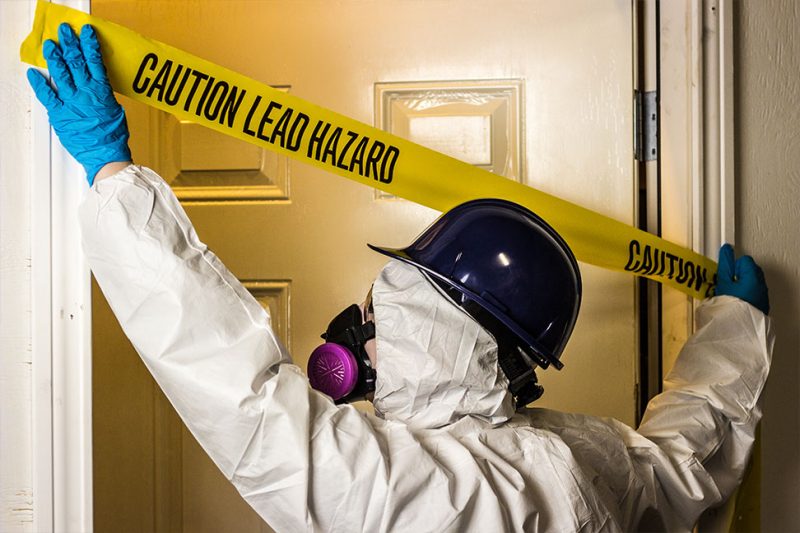The Process of Lead Abatement
Lead abatement is an important process that contributes to improved public health by reducing lead contamination in our air, soil, and water. Unfortunately, many people are unaware of the abatement process and the potential dangers associated with lead exposure. To better understand this process and its benefits, we’ve compiled a comprehensive overview of lead abatement.
What is Lead Abatement?
Lead abatement is the process of reducing or eliminating lead from dwellings or other areas where it may be found. It can include painting or encapsulating lead-contaminated surfaces, tearing out lead-containing materials, repairing windows and doors, cleaning up lead dust, or through other methods.
Why is Lead Abatement Necessary?
Lead is a toxic metal that has been used in many products and buildings over the years. Exposure to lead can cause serious health problems, especially in children. The abatement process helps to prevent exposure to lead and is an important way to protect public health. Some of the potential health effects of lead exposure include:
- Cognitive delays
- Attention and behavior problems
- High blood pressure
- Kidney damage
- Neurological effects
Who Performs Lead Abatement?
Lead abatement projects are typically completed by specialized professionals who have the required training and experience to safely manage lead-related work. Contractors must be certified and accredited with their state and/or the Environmental Protection Agency (EPA) to practice lead abatement. These professionals take extra precautions to protect themselves, their workers, and the public when performing the abatement process.
What is Involved in the Process of Lead Abatement?
The lead abatement process involves several steps, including:
- Assessment: A Licensed Lead Inspector will inspect the property to identify any surfaces or materials that may contain lead or be suspected of containing lead.
- Remove/Contain: Any lead-containing materials identified in the assessment will be safely removed or encapsulated to prevent further lead exposure.
- Clean-up: All impacted areas will then be thoroughly cleaned to remove any remaining lead dust and particles.
- Monitor: The property will then be monitored to ensure that levels of lead exposure are within acceptable limits.
How Can I Find a Qualified Lead Abatement Contractor ?
It is important to work with a qualified contractor to ensure that the lead abatement process is performed safely and effectively. To find a qualified lead abatement contractor in your area:
- Ask friends, family, and neighbors for referrals.
- Check with the state or EPA Lead abatement information centers.
- Research online reviews of local contractors.
- Ensure that the company is certified and accredited to perform lead abatement.
What Should I Expect When Hiring a Lead Abatement Contractor?
When contracting with a lead abatement contractor, there are several steps to take prior to hiring. Be sure to:
- Request a copy of their license and certification.
- Request a written contract which details the terms and costs.
- Request a handbook or manual on the safe disposal of lead-related materials.
- Request evidence of liability insurance.
- Request a list of references from previous projects.
Are There Special Considerations for Lead Abatement?
Yes – it is important to be aware of the potential risks involved with lead abatement. Lead is a toxic metal that can cause severe illness when inhaled or ingested. Many lead-containing materials, such as old paint, are dusty and can spread lead contamination. Be sure to take the necessary precautions to protect yourself and those around you from hazardous materials.
What Can I Expect After the Lead Abatement Process?
Once the lead abatement process is complete, the contractor will perform a post-abatement inspection to ensure that the project was completed properly and that the lead levels are now within acceptable ranges. The contractor will also provide you with a detailed report of the work that was completed and a certificate of completion.
The Benefits of Lead Abatement
Lead abatement is an important public health issue that can help to prevent serious health problems caused by lead exposure. By following the proper lead abatement process, you can help to protect yourself, your family, and your community from the potential dangers of lead contamination.
Conclusion
Lead abatement is a critical process that helps to prevent lead contamination in the environment. By understanding the process and taking the necessary steps to hire a qualified contractor, you can help to ensure that lead levels on your property are managed safely and effectively. The process of lead abatement is an important part of protecting public health and ensuring a safe and healthy environment for all.
What criteria must be met for a successful lead abatement project?
1. A lead abatement specialist should be employed to identify potential lead hazards and assess the related risks.
2. An approved containment and removal plan must be implemented to ensure a safe and effective abatement process.
3. All abatement materials and activities must follow local, state and federal regulations and standards.
4. The abatement site must meet all clearance tests and post-abatement monitoring requirements prior to re-occupancy.
5. The abatement contractor must provide documentation of lead abatement activities, including test results and final clearance results.
What qualifications are needed for lead abatement professionals?
Lead abatement professionals typically need to possess a certification or other type of qualification to ensure they are appropriately trained and knowledgeable about lead abatement. Common qualifications sought include the EPA Lead Renovation, Repair and Painting (RRP) certification, the National Lead Certification for Renovation and Painting (NLCRP), and the American Society for Testing and Materials (ASTM). Depending on the jurisdiction, additional certifications or license may be necessary. Additionally, lead abatement professionals may be required to have specific experience in the field as well as knowledge of federal, state and local government regulations.
What certifications do lead abatement professionals need?
Lead abatement professionals usually need certifications from the Environmental Protection Agency (EPA) or their state’s health department demonstrating their knowledge and competency in the lead abatement field. Potential certifications include the Lead Risk Assessor, Lead Inspector, Lead Abatement Supervisor, or Lead Abatement Worker certifications, among other relevant certifications.





